Table of Contents

Selecting one of the best microphones for recording vocals will be a challenging task most of the time. This is because there are countless choices present on the internet. However, if you know your requirements, you can easily zero down on the microphone choices. This is where the buying guide will help you figure out small little and minute details about the microphone for recording vocals. After that, you can look for the best microphones I have listed for recording vocals.
I would also like to mention that I have tried my best to enlist microphones so you can get a glimpse of various microphones. I have listed some of the less expensive microphones for vocals; on the other hand, I have also listed some of the costly microphones that will offer you additional features and better build quality. Hence, you can be sure that you will be able to find the best microphone for recording vocals for yourself.
The 8 Best Microphone For Recording Vocals
-
Shure SM7B Vocal Dynamic Microphone
Product Dimensions: 13.3 x 7.2 x 4.8 inches.
Connectivity Technology: XLR.
Positive: Includes Shock Isolation And Pop Filter, Provides XLR Connection, Rugged Construction.
Negative: Build Quality Is Questionable.
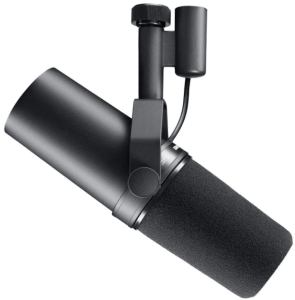 The Shure SM7B Vocal Dynamic Microphone is an impressive feat of engineering. Its advanced dynamic cartridge replicates music and speech with exceptional clarity, producing a smooth wide-range frequency response that is audible and pristine. To further augment this superb sound quality, the microphone has air suspension shock isolation and a pop filter to eliminate mechanical noise, breathiness, and audio interference.
The Shure SM7B Vocal Dynamic Microphone is an impressive feat of engineering. Its advanced dynamic cartridge replicates music and speech with exceptional clarity, producing a smooth wide-range frequency response that is audible and pristine. To further augment this superb sound quality, the microphone has air suspension shock isolation and a pop filter to eliminate mechanical noise, breathiness, and audio interference.
It features a cardioid pattern, so only one side receives sound while the other rejects off-axis audio sources. The electromagnetic shielding blocks out hum from computer monitors and other studio equipment, ensuring that only the best quality sounds are recorded. Lastly, its rugged construction allows you to securely attach the microphone cartridge with an attachable close-talk windscreen and switch cover plate for added protection and longevity.
Customer Review For Shure SM7B Vocal Dynamic Microphone

-
Electro-Voice RE20 Broadcast Announcer Microphone
Product Dimensions: 1 x 1 x 9 inches.
Connectivity Technology: Wired.
Positive: Features Large Diaphragm, Includes Bass Roll-off Switch, Magnetic Shielding.
Negative: Buzzing Interface.
 With the renowned Electro-Voice RE20 Broadcast Announcer Microphone, you know you’re getting quality and innovation. Its patented Variable-D design offers superior gain before feedback. At the same time, its heavy-duty internal pop filter excels in close-in voice work.
With the renowned Electro-Voice RE20 Broadcast Announcer Microphone, you know you’re getting quality and innovation. Its patented Variable-D design offers superior gain before feedback. At the same time, its heavy-duty internal pop filter excels in close-in voice work.
The microphone’s steel case provides excellent magnetic shielding to ward off line hum. The large diaphragm allows your recordings to reach a higher level of clarity and detail. The bass roll-off switch gives you control over the low-frequency content of your recording – perfect for any sound engineer or someone looking to produce broadcast-quality results.
Customer Review For Electro-Voice RE20 Broadcast Announcer Microphone

-
Audio-Technica AT2020 Cardioid Microphone
Product Dimensions: 9.6 x 9.6 x 2.6 inches.
Connectivity Technology: Wired.
Positive: Includes Low-mass Diaphragm, Cardioid Polar Pattern, Gives High SPL Handling.
Negative: Some Quality Issues.
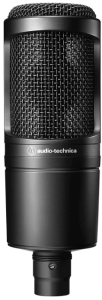 The Audio-Technica AT2020 Cardioid Microphone offers the best of both worlds regarding sound quality and performance. With a noise floor of only 20 dB SPL, this microphone ensures that all your recordings come out crystal clear. Additionally, its wide dynamic range, high SPL handling capabilities, and custom-engineered low-mass diaphragm provide unmatched versatility to capture any sound.
The Audio-Technica AT2020 Cardioid Microphone offers the best of both worlds regarding sound quality and performance. With a noise floor of only 20 dB SPL, this microphone ensures that all your recordings come out crystal clear. Additionally, its wide dynamic range, high SPL handling capabilities, and custom-engineered low-mass diaphragm provide unmatched versatility to capture any sound.
Its cardioid polar pattern also helps to pick up far less background noise than other mics on the market by isolating the desired sound source. Fans of audio recording have never had such an incredible advantage in choosing the right microphone for their needs.
Customer Review For Audio-Technica AT2020 Cardioid Microphone

-
AKG Pro Audio C414 XLII Vocal Condenser Microphone
Product Dimensions: 11.3 x 9.6 x 5.5 inches.
Connectivity Technology: Wired.
Positive: Features Nine Selectable Polar Patterns, Offers a Bass-cut Filter, and Includes an Overload Warning Function.
Negative: Expensive Than Others.
 The AKG Pro Audio C414 XLII Vocal Condenser Microphone is the perfect choice to capture the best-sounding music. It provides nine selectable polar patterns, offering ultimate versatility with any setup. With its three attenuation levels (-6/-12/-18db), it can quickly adapt to close-up recording or high-output sources of up to 158db SPL.
The AKG Pro Audio C414 XLII Vocal Condenser Microphone is the perfect choice to capture the best-sounding music. It provides nine selectable polar patterns, offering ultimate versatility with any setup. With its three attenuation levels (-6/-12/-18db), it can quickly adapt to close-up recording or high-output sources of up to 158db SPL.
It also features an overload warning with an audio peak hold LED, allowing you to detect the shortest audio peaks possible. Three switchable bass-cut filters reduce wind noise, minimize stage vibration or prevent extreme proximity effects. Professionals from all genres of music can enjoy premium sound recording with this powerful microphone.
Customer Review For AKG Pro Audio C414 XLII Vocal Condenser Microphone

-
Rode NT1-A Large-Diaphragm Microphone
Product Dimensions: 15.25 x 4.5 x 11 inches.
Connectivity Technology: Wired.
Positive: Gold Plated Diaphragm, Cardioid Polar Pattern, 10-Year Extended Warranty.
Negative: Some Quality Issues.
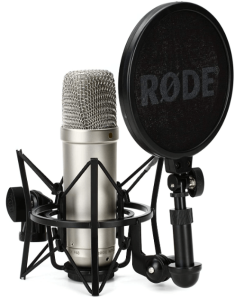 The Rode NT1-A Large-Diaphragm Microphone is perfect for clear and precise sound. With its gold-plated diaphragm and cardioid polar pattern, this microphone provides the high-quality audio recording with an ultra-low noise of just 5dB.
The Rode NT1-A Large-Diaphragm Microphone is perfect for clear and precise sound. With its gold-plated diaphragm and cardioid polar pattern, this microphone provides the high-quality audio recording with an ultra-low noise of just 5dB.
Furthermore, its transformerless surface mount circuitry gives you a wide dynamic range making it well-suited for both vocal and instrumental work. As if that weren’t enough, Rode also offers an extended ten-year warranty, ensuring long-lasting satisfaction.
Customer Review For Rode NT1-A Large-Diaphragm Microphone

-
MXL 990 Industries Condenser Microphone
Product Dimensions: 11.77 x 7.28 x 3.5 inches.
Connectivity Technology: XLR.
Positive: FET-Based Design, Vintage Body, Includes Mic Stand Adapter.
Negative: Doesn’t Sound Properly.
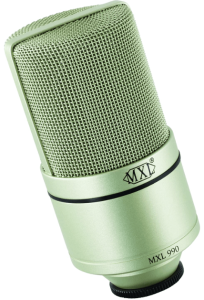 The MXL 990 Industries Condenser Microphone is designed with all the features necessary to record a professional-level sound. Its FET-based design and transformer-balanced output ensure optimal sound clarity across various applications.
The MXL 990 Industries Condenser Microphone is designed with all the features necessary to record a professional-level sound. Its FET-based design and transformer-balanced output ensure optimal sound clarity across various applications.
It also has a vintage body style with a champagne finish, offering a silky sweet high end while maintaining firm and solid lows and mids. Additionally, this microphone comes with a custom shock mount, mic stand adapter and carrying case, and 48V phantom power requirements.
Customer Review For MXL 990 Industries Condenser Microphone

-
Neumann TLM 102 Condenser Microphone
Product Dimensions: 9.8 x 4.6 x 2.6 inches.
Connectivity Technology: XLR.
Positive: Easy To Carry, Gives Fast Transient Response, Small Size.
Negative: Some Distortion Issues.
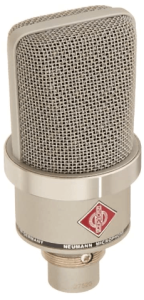 The Neumann TLM 102 Condenser Microphone provides superior audio performance due to its large diaphragm and cardioid directional characteristic. With a compact Neumann design and a maximum sound pressure level of 144 dB, its transformerless circuitry ensures high SPLs without any distortion.
The Neumann TLM 102 Condenser Microphone provides superior audio performance due to its large diaphragm and cardioid directional characteristic. With a compact Neumann design and a maximum sound pressure level of 144 dB, its transformerless circuitry ensures high SPLs without any distortion.
Additionally, the slight presence boost above 6 kHz helps vocals to stand out in the mix, making it a premier choice for recording engineers and producers.
Customer Review For Neumann TLM 102 Condenser Microphone

-
Blue Yeti X Professional Microphone
Product Dimensions: 4.33 x 4.8 x 11.38 inches.
Connectivity Technology: Wired.
Positive: Four-Capsule Array, Gives Multi-Function Smart Knob, Offers Easy-Access Controls.
Negative: Incompatible Connections.
 The new Blue Yeti X professional microphone is a powerful tool for anyone recording audio, from professional broadcasters to leisure streamers. This powerful mic packs a four-capsule array of broadcast-quality sound clarity and focus, perfect for taking your audio game up a few notches.
The new Blue Yeti X professional microphone is a powerful tool for anyone recording audio, from professional broadcasters to leisure streamers. This powerful mic packs a four-capsule array of broadcast-quality sound clarity and focus, perfect for taking your audio game up a few notches.
Its built-in LED metering allows you to visualize your voice levels at a glance to adjust levels up or down easily. You can also fine-tune your on-stream sound with multi-function controls for microphone gain, mute, headphone volume, and blend.
Customer Review For Blue Yeti X Professional Microphone

What Are Microphones For Recording Vocals?
Microphones for recording vocals will capture sound waves and convert them into electric signals. They define your sound quality from where it is first recorded organically. These microphones highlight vocal frequencies that define speech transmission through the mic. Their core construction comprises a capsule or baffles that captures the sound and turns it into electrical energy.
This capsule has a thin membrane known as the diaphragm, which vibrates when it comes in contact with sound waves that turn into electric signals.
Singers and podcasters for YouTube record their voices using condenser microphones specifically designed to record vocals. In most cases, microphones for vocals reject audio from other sound sources from bleeding into or leaking into the audio recording.
Different Types Of Microphones
Different microphones record different qualities of audio, and there is no one-size-fits-all rule for selecting the ideal microphone type. Some could be powerful, sophisticated, or simple. The three main types are dynamic microphones, condenser microphones, and ribbon microphones.
-
Dynamic Microphones
Theoretically, these microphones are transducer audio devices with permanent magnets that create a magnetic field that moves the diaphragm to create the sound. Therefore, they do not require any external power to function. In addition, this microphone supports high sound pressure levels (SPL) due to its versatility and durability and can withstand stronger sound sources.
These microphones have sturdy capsules and are a good choice for handheld vocal mics required at live events. For example, dynamic microphones can be used for guitar amps and snare drums, and even singers use them at live concerts where the volume levels are high.
-
Condenser Microphones
Condenser microphones are in that category of microphones that depend on a sensitive vibrating diaphragm to record audio. They require an external source for generating power, like a phantom power source or power amplifiers. Condenser microphones have a diaphragm that is suspended by a fixed plate, which moves when sound waves pass through it.
These types of microphones can be considered great for recording vocals and require a more controlled setting by using a pop filter that prevents unwanted air from bursting into your mic.
-
Ribbon Microphones
It is a type of microphone that has a thin strip made up of aluminum that is suspended in a magnetic field to produce electromagnetic induction. This ribbon works as a diaphragm and a transducer that gives the sensitivity of a condenser mic but is quieter and more fragile.
What Is The Proximity Effect?
The proximity effect is defined as the increase in the frequency response that accentuates the lower frequency range. The exaggeration of low-frequency response in directional microphones occurs due to the audio source’s proximity to the mic.
It is the effect of a sound recorded by the microphone when the audio source moves closer to the microphone. Most audio engineers know that the sound gets more bass when the singer is closer to the mic. However, the voice gets thinner when the singer moves away from the mic. You can hear its effect on YouTube and other audio and video streaming platforms, where the vocalist appears to be almost touching the mic and generates a deep bass effect.
How To Choose The Right Microphone For Recording Vocals?
Now that we know the types of microphones and the proximity effect, let us move to the specific points using which, you can select one of the best microphones for recording vocals. Do keep in mind the above terminologies when going through the below points.
-
Usability
The best microphone would be the one that is devoid of many technical problems. If you think you understand a specific type of mic better, you can definitely go for that one. Adding to it, you can look for a simple setup that will help you record your audio without learning excessive details regarding its installation and other technical setup details. If you are just starting out, you can start with a basic condenser mic.
-
Test Microphone's Directionality
It would be best if you also had a basic understanding of polar patterns. The direction of the microphone is the method of how it captures or records sound. For vocals, a more focused and directional microphone would suit best that collects the audio directly from the audio source in its front.
These microphones should have a cardioid polar pattern that eliminates ambient noise and captures more precise audio quality within proximity. You can use a basic shotgun mic if you do not have a proper setup for recording vocals. This will allow you to record clear audio from the front side while it will reject most of the sounds from the surroundings.
-
Know About Microphone's Frequency Response
It is the range of sound a microphone can reproduce, which also determines the signature of any mic. Therefore, the sound ranges vary in that specific sound range. For example, for capturing a male vocal, you can look for larger diaphragm mics that pick lower deep bass frequencies. However, you could use small diaphragm microphones for female vocals to capture higher frequencies.
-
Select A Pop Filter
For those who do not know what a pop filter, pop screen, or pop shield is, let me tell you that it is a filter that is attached to the front of the mic. Having a pop filter serves two purposes, in my opinion. First, it gives a cooler look to your microphone; second, it reduces the overall impact of the air that goes into the microphone. Using a good pop filter decreases the effect of unwanted noises, the hissing noises or sibilance, and the plosives sounds of letters P and B.
Having said all that, you should not confuse a pop filter and mic cover with one another. They both are entirely different and are used in different circumstances.
-
Shock Mount
A shock mount is a mechanical fastener that holds the microphone in place while protecting it from stand vibrations by holding them with elastics. A shock mount is one of the essential pieces of equipment as it protects the mic from any of the low-frequency disturbances caused by hand movements or if your hand touches the mic while you are recording the audio. Most manufacturers of shock mount manufacturers use suspension for absorption of any vibration.
-
High-Quality Cables
Although the cheapest cable will also do the job for you, going for a quality microphone cable is essential when it comes to recording quality audio for yourself. One of the main reasons is that it will protect the audio quality from external interference. The mic levels are very very low voltage; as a result, they are more prone to any disturbances from external sources such as radio waves and electromagnetic signals, etc.
For all the reasons stated above, I always go for a premium-quality audio cable that will last longer. You will not like when some unwanted noise gets recorded into your precious audio.
-
Mic Stand
It is free-standing support for your microphone. Mic stands have these microphones, and pop filters mounted on them. They can make or break your audio recording setup. Tripod stands can work well for mic dips that are half an inch screw-in top.
-
Sound Pressure Level (SPL)
It is the pressure variation in the air caused by sound waves. The sound pressure level is defined as the maximum amount of pressure of the sound, your microphone can handle before it cannot handle it anymore. It is calculated in decibels and you need around 100dB for quality vocal recording. In humans, the lowest sound pressure level is called the hearing threshold, while the highest sound pressure level is known as the pain threshold.
-
Budget
Budget plays a major role when selecting a microphone for recording vocals. If you want a sturdy construction in your microphone, you can look for Shure Vocal Dynamic Microphones that fall within the price range of $350-$400.
Whereas, if you want broadcasting-level audio quality, you can try the Electro-Voice wired microphones that also have magnetic shielding which can cost you around $400-$460.
If you want a microphone that has numerous pick-up patterns to record your vocals, you can give AKG Pro Audio Condenser Microphones a try as they can easily adapt to close-up recording up to 158dB SPL.
Conclusion
I hope that by now, you might have a basic idea of which microphone to choose for recording vocals. Or at least you would have listed down your requirements according to which you will select your personal best microphone for recording vocals.
The list provided by me is not a complete one; as a result, if you feel that I might have missed mentioning something that should be on this list about best mics for vocals, then I will welcome you to the comment section, where you can drop your precious suggestions.
Frequently Asked Questions/FAQs
6-12 inches far away from your mouth is the ideal distance required for setting up a vocal microphone as it should be closer enough to record only your voice and not the surroundings.
Yes, dynamic mics are good for recording voice that includes podcasting to singing, and are considered good for recording various people in the same room when the sound source is extremely loud.
-12 to -20 decibels is considered a good range for recording vocals at 24-bit bit-depth. However, recording at higher levels can cut your audio quality.